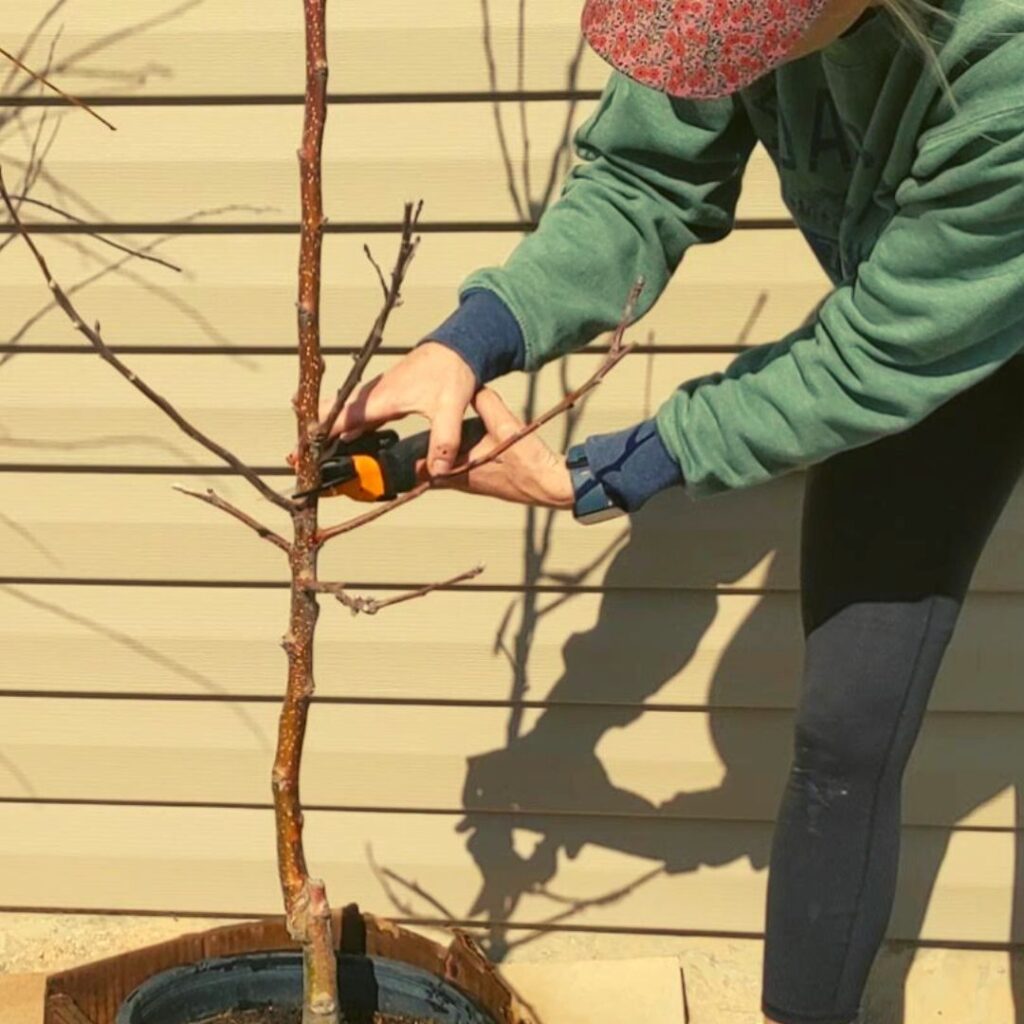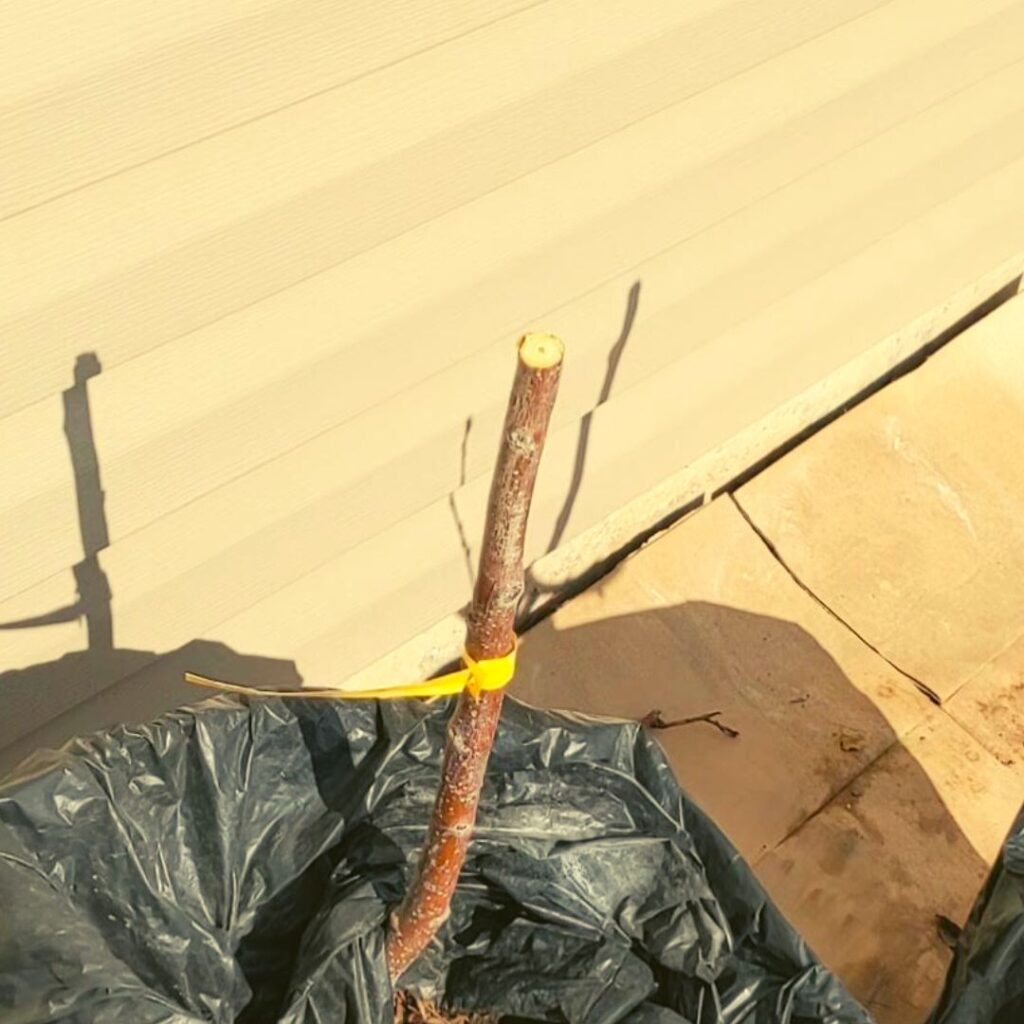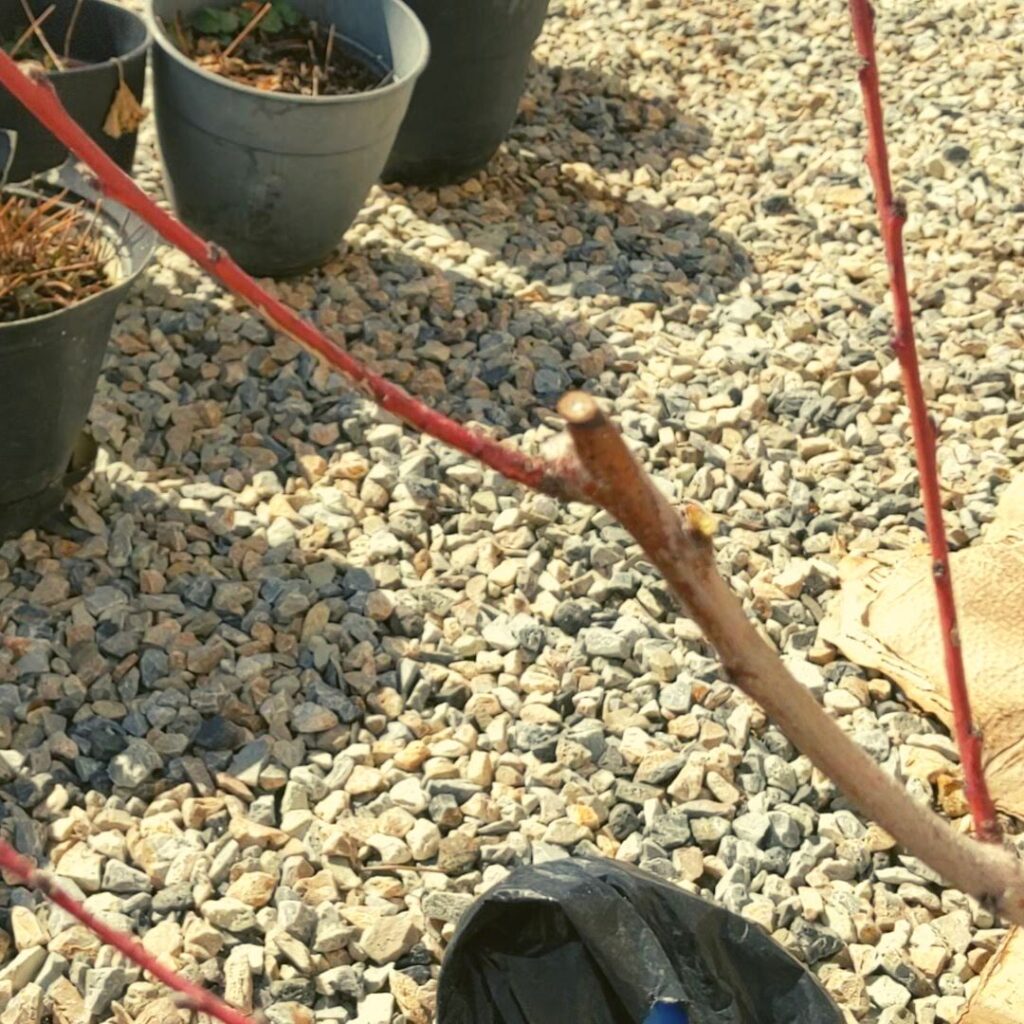Prune Fruit Trees: How to Keep Trees Small
I am here to discus how to prune fruit trees and how to keep trees small. This guide will help you on your fruit tree pruning journey!

Years ago, I dreamed of growing my own fruit trees. We were living in an apartment and all I could do was research about fruit trees. Well all that research proved to be helpful, because now I am able to prune my own fruit trees.
But I didn’t want a normal fruit tree, I wanted to grow a small fruit tree. I hoped it would stay a manageable size and that it would resist the wind we get here in the high desert.
I gained inspiration from the book Grow a Little Fruit Tree by Anne Ralf. I will give you my experience with heavy pruning from her teachings. My hope is that it will give me small fruit trees long term.
If you have no idea how to prune fruit trees, then you should check out her book, she really makes it seem less stressful and more like you can’t mess things up. But I will admit, That first cut was a little scary to make, but after that, it was cake.
With more pruning experience you feel more like an artist who gets to shape the trees. I actually have started to really love pruning fruit trees and keeping them small.
Why should I grow small fruit trees?

When you prune fruit trees to be small, they are a more manageable size and can fit in small spaces. They are great for the backyard gardener or if you want to grow a lot of fruit trees in a small space.
Usually in order to keep your fruit tree small, you need to start with a new tree or with less mature trees. Small fruit trees will bear less fruit, but the fruit production will be a more manageable amount.
Bi annual pruning will allow you to create beautiful trees that are small in size even as mature trees.
It also gives you the chance to create more healthy trees that don’t have breaking branches from overproduction of fruit.
I really just like the idea of being able to reach all parts of my tree from the ground or a small step stool.
This makes it easier to cover your tree from birds or squirrels. Or, in my case, any late frosts that seem to ALWAYS come. I can easily toss a cover over the blooming trees to protect their tender little blossoms!
Step by step guide on how to prune fruit trees and how to keep them small
In order to grow small fruit trees you need to start with young trees. Older trees will not do well with the first initial cut that will be required to grow a smaller fruit tree.
It is a good idea to plan to prune your fruit tree during late winter when the tree is still dormant. This is the perfect time because the tree is able to handle the shock from that aggressive cut.
Your main goal with growing a small fruit tree is to keep the main trunk short. Anne Ralf suggests knee high, which seems crazy, I know. But it works!
Step One: The first cut
The best time to do the first cut is when you have a new fruit tree at just before planting time. This should be done the first year of owning your tree and it should be knee high.
This will make it so that you will have lower branches and thus a shorter tree. Sometimes your tree will simply look like a stick coming out of the ground, and that’s okay.

With some of my trees that I bought, the scaffold or lower branches were already knee high, so I just shortened the limbs and if there was a tall central leader, I would cut that down to the knee high crotch of the tree.

For me, this cut was a little scary, but once you get the first one done, you get stronger and braver. This cut is worth doing, I promise.
Fruit trees grow so fast that you will see branches coming out in a month or two. When the tree begins to push out little branches from your cut, it will likely push out more than you want.
Pluck off any that are coming from the same spot or are too close. A good rule of thumb is to leave three or four spaced out branches that don’t overlap each other.

Step Two: Summer pruning
There will be a ridiculous amount of new growth that will come after your first cut. The purpose of the summer prune is to shorten your tree canopy with heading cuts (cuts that shorten the branch).

This will keep the tree short and there is a good chance that you will be cutting up to 2/3 of the tree from the top. You will do this pruning early summer, Anne Ralf suggests trying to do it during the summer solstice.
I would recommend that in the first year of having your tree that you remove all the flowers from your tree. This means you will get no fruit this year.
BUT it will allow your tree to put all of it’s energy into growing a stronger root system. You will also do thinning cuts ( removing unwanted branches). Get rid of any vertical branches or overlapping branches.
Prune tree branches that grow inward towards the center of the tree. You will want to strive with growing an open centered tree. This allows more sunlight to reach the entire tree.
Trees like apple or pear trees like to have a central leader and may be difficult to prune with an open center, but with bi annual pruning, it is possible.
If you have a stubborn tree, go ahead and let it have a central leader. Other branches you will want to remove are suckers.
These are branches that try to grow from the bottom of the tree. Just know that you need to get rid of any branches that are below your original scaffold branches.
Step Three: Winter pruning
Now you have made it a full year with your tree. Keep your winter pruning’s (after the first cut) less aggressive. Anne Ralf suggests that intense winter pruning promotes vigorous growth.
Leave extreme heading cuts to summer pruning (besides the first cut). This is the time where you prune to get the shape you want for your tree, remove dead branches, diseased branches or suckers.
If you didn’t make as short of a cut as you wished the year before, you can do that cut now, just know that it will delay your tree from giving fruit for another year or so.
Again, this prune should happen late winter/early spring. I usually find a nice day in February to do this cut.
Dormant pruning is a little easier because you can see the shape of the tree better without all the leaves. You get to decide what shape you want your tree to be.
This is the fun part. You can’t get it wrong. YOU are the artist. If a certain prune didn’t go as you liked you can always change it the following year.
Fruit Tree Pruning Tips

- Clean your pruners after each tree. This will prevent the spread of disease if you have a diseased tree.
- Heading cuts: Shorten or eliminate a branch promoting buds or branches below it to grow. These should be done on a 45 degree angle with an outward facing bud. Don’t cut the actual bud. Whatever bud you cut above that is the direction where your next branch will go, this is why you want it to face outward so that it doesn’t grow into the tree on cross over the branch next to it.
- Main branches: You don’t want your main branches more vertical or horizontal with a crotch angle of 45 degrees. If your branch is too vertical, prune so that an outward facing bud will grow promoting more of an angle. If the branch is more vertical then I would suggest rigging up a brace that pushes the branch outward more.

- When doing heading cuts don’t cut the actual bud. leave the notch of the bud space.
- With thinning cuts, cut right above the notch or ridge that the branch comes out of. Sometimes little branches will try to grow out of that nub later, simply remove them while they are young. If you do, the cut will heal nicer and you can do it with your fingers.
- Thin your fruit every summer. When your fruit starts to form, It will usually form a cluster of fruit in one place. As hard as it is, you will want to remove every fruit except one in each cluster. At least 4-6 inches between each fruit. Some people do a full foot! You will get larger, better tasting fruit from doing this.
Can I just buy a dwarf tree?
Well you can, but the term “dwarf” can be misleading. Apple trees can get up to 60 feet tall. If you buy a dwarf variety of apple tree, you will end up with a 30 foot tree.
A 30 foot tree still requires a ladder for harvesting and pruning and is much too tall in my opinion. It will still be a “dwarf” compared to 60 feet, but still HUGE.
If you want your tree shorter than ten feet, you will need to prune trees twice a year, dwarf variety or not
What fruit trees can be pruned small?

- Apple Trees
- Pear Trees
- Cherry Trees
- Plum Trees
- Peach trees
- Fig Tree
Really any type of fruit trees can be pruned to be small, whether they are pome fruits or stone fruits. You are the decider of the size of your fruit tree.
What fruit trees are you growing this year? Comment below your favorite fruit to harvest!
Dehydration is a great way to preserve your harvest! Check out my dehydration recipe below!


I pruned my trees in the fall, and now the shoots are growing back up in the spring. I’m thinking whether to cut them again, although it’s summer, wait until autumn again?
Are you wanting your tree to stay small? If yes, then doing some thinning cuts and heading cuts can be done in the summer. Best pruning practices are done late winter when the tree is dormant. I usually do it in January or February.
If you have little shoots coming from the base of the tree or below your scaffold branches, you can remove them in the summer.